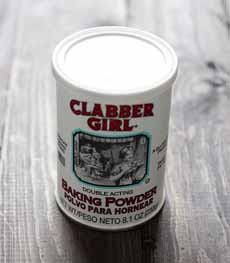FOOD 101: Baking Powder History (Where Would We Be Without It?)
 [1] Fluffy biscuits need baking powder (photo of buttermilk biscuits © Robyn Mackenzie | Fotolia).
|
May 14th is National Buttermilk Biscuit Day. Head to your grocer’s refrigerator section to buy a tube, or make buttermilk biscuits from scratch.
Either way, these high-rising biscuits, along with tall layer cakes and fluffy pancakes, owe their height to baking powder. When first patented in 1856, it was a revolutionary product. Baking powder is a dry chemical leavening agent, a mixture of an alkaline sodium (e.g. bicarbonate) and a weak acid salt (e.g. cream of tartar). When combined with a liquid, the acid-base reaction releases carbon dioxide into the batter or dough, which increases the volume and lightens the texture. This is the definition of a leavener: a substance that creates this chemical reaction. It was so important to cooking, that a vicious battle for brand domination in America arose in the latter half of the 19th century. Read about it in Baking Powder Wars: The Cutthroat Food Fight that Revolutionized Cooking. According to a review of the book in Extra Crispy, which begins its story in 1700s colonial America, the mark of a woman’s cooking skill was the quality of her bread. Was it soft or leaden? Bread was a large component in Colonial meals. A woman who couldn’t bake a good loaf was not a good woman, wife or mother. Yet, housewives had only wild yeast for leavening—an ingredient used since the dawn of baking. However, it required that the wild yeast fly through the window and settle on the dough. Commercial yeast from the Fleischmann Brothers would not be sold until 1868 (the history of yeast). Desperate housewives experimented with other household options. Scoop out the ashes from the fireplace (or use other burned plant material), soak them in water and you get a dilute form of lye. This mixture was used to make soap and gunpowder. It turned out to be the best-so-far leavener for baking. Some readers will recognize potassium carbonate as the base ingredient of lye. For those wondering about how people can eat lye: It works in dilute forms (low concentrations) and is used to make other food products. Olives are traditionally brined in lye water. Pretzels get a lye bath, as do hominy, ramen and nixtimalized corn/masa that is used to make tortillas. The Scandinavian specialty, lutefisk, is soaked in water and lye. O.K. However, pearl ash wasn’t perfect. It didn’t dissolve that easily, and wasn’t good for batters that contained ample fat (butter or oil). There, it generated a soapy taste, which was no surprise since soap was then a combination of lye solution and fat. So the search continued. Let’s start with baking soda, the chemical compound sodium bicarbonate. We know that as far back as 3500 B.C.E., the ancient Egyptians used a form of it (natron, primarily comprised of sodium carbonate) as a soap-like cleaning agent and in the mummification process. Sodium bicarbonate expanded in use: to brush teeth, to wash laundry, as an antacid and more. More recently, it has been turned into a deodorant for self, and fridge and cat litter. It’s also a main ingredient in fire extinguishers, which is why consumers are told to dump baking soda on grease fires. In 1843, baking soda crossed over to food. |
|
|
Alfred Bird, a British chemist, used it as the base to make the first baking powder leavener for his wife, who was allergic to yeast [source]. Around the same time, Dr. Austin Church, an American medical doctor from Connecticut, developed his own version. In 1946 he joined with his brother-in-law John Dwight, who had his own Cow Brand of “aerated salt,” called Dwight’s Saleratus. Salertus is a combination of pearl ash had carbonic acid, which creates potassium bicarbonate. The brand eventually became Arm & Hammer Baking Soda.The familiar logo of Vulcan’s* flexed right arm holding the hammer wasn’t added until 1878, after an earlier family venture, Vulcan Spice Mills, which used a similar logo [source]. Baking powder is a combination of baking soda, also a leavener (sodium bicarbonate), mixed with an acid salt, usually cream of tartar, and cornstarch (as a thickener). Baking powder was not just an American phenomenon. It was commercially launched in England in 1843 by Alfred Bird (better known for his invention of Bird’s Custard, an egg-free powder that was reconstituted with water). In 1856, a Harvard chemistry professor, Eben Horsford, developed an improved baking powder under the Rumford name, using monocalcium phosphate, a compound he patented. By 1896, the U.S., population 76 million, was using some 120 million pounds of baking powder annually. French chefs used whisk-whipped egg whites to add lightness to baked goods like sponge cakes, and other foods like mousse. But unless you had major upper arm muscles, you waited until the end of the 19th century, when mechanical egg beaters were invented. (The first U.S. patent was in 1859, with an improved version patented in 1870. Cooks had to wait until 1908 for the first electric mixer.) Baking soda and baking powder are the two modern leaveners. They’re not interchangeable; they have different additives and strengths. Here’s the difference. Because modern food preservatives did not exist, bread quickly became stale. ________________ *Vulcan is the Roman god of fire and metalworking. He came to be known as a symbol of industry. Variations of the arm and hammer are used by other companies, universities, and organizations in the U.S. and Europe. It’s on the state flag of Wisconsin and the symbol of the Socialist Labor Party of America. Here’s the history of the arm-and-hammer image. |
||


